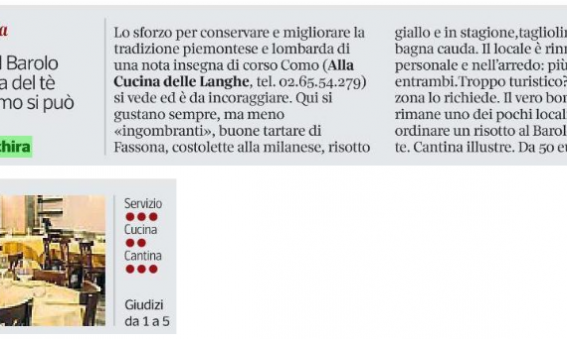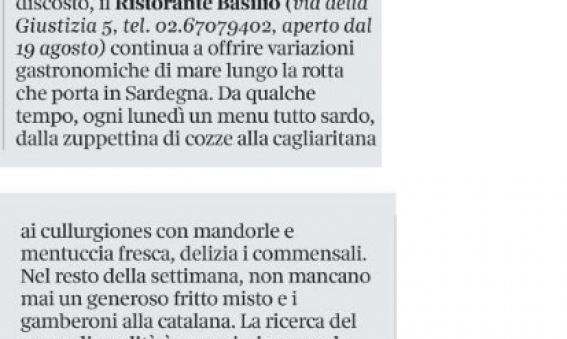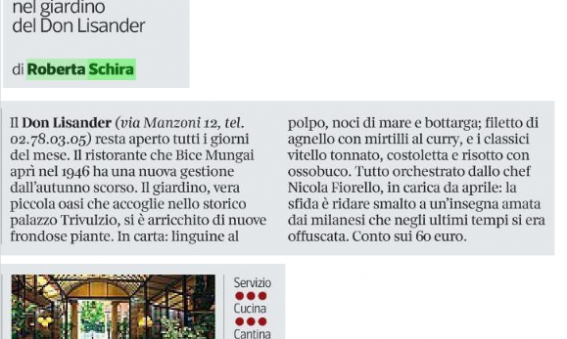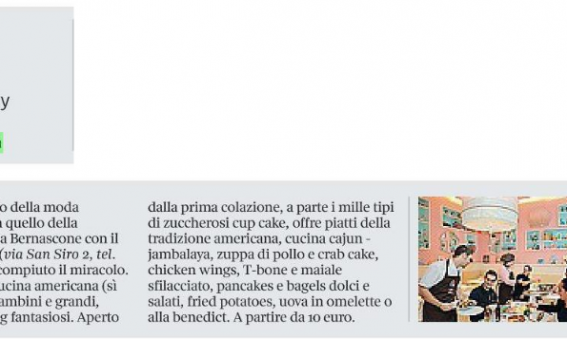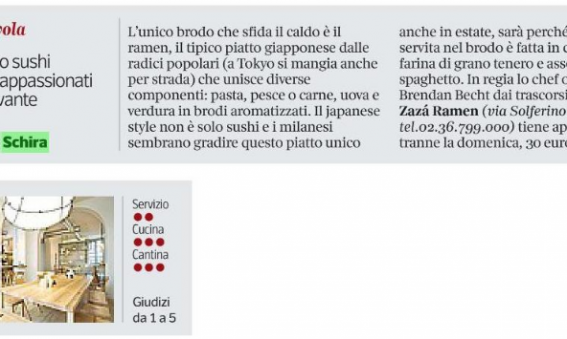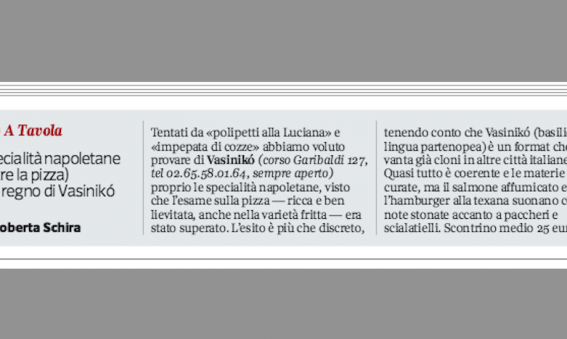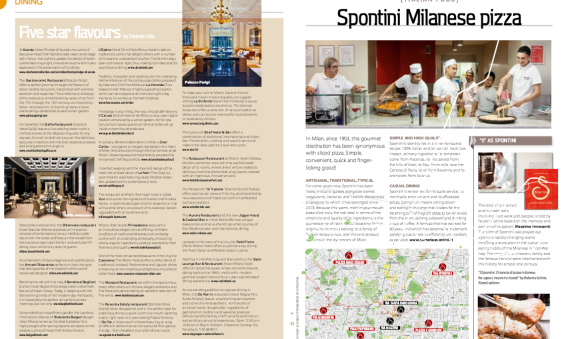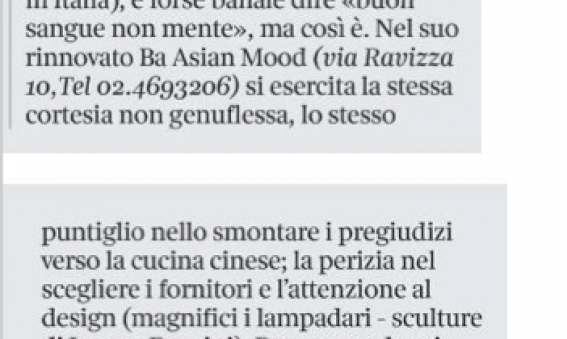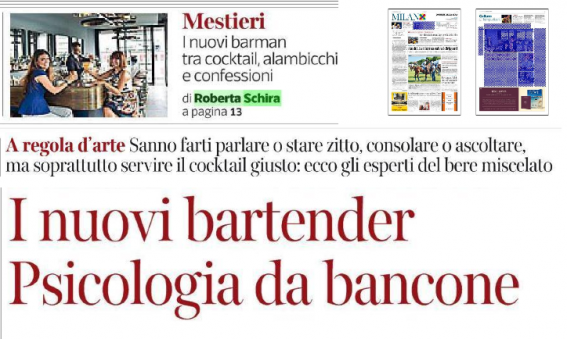Lo sforzo per conservare e migliorare la tradizione piemontese e lombarda di una nota insegna di corso Como ( Alla Cucina delle Langhe , tel. 02.65.54.279) si vede ed è da incoraggiare. Qui si gustano sempre, ma meno «ingombranti», buone tartare di Fassona, costolette alla milanese, risotto giallo e in stagione,tagliolini e tartufo o bagna cauda. Il locale è rinnovato nel personale e nell’arredo: più freschi entrambi.Troppo turistico? Forse,ma la zona lo richiede. Il vero bonus è che rimane uno dei pochi locali dove si può ordinare un risotto al Barolo all’ora del te. Cantina illustre. Da 50 euro.
A un passo dalla Martesana, un po’ discosto, il Ristorante Basilio (via della Giustizia 5, tel. 02.67079402, aperto dal 19 agosto) continua a offrire variazioni gastronomiche di mare lungo la rotta che porta in Sardegna. Da qualche tempo, ogni lunedì un menu tutto sardo, dalla zuppettina di cozze alla cagliaritana ai cullurgiones con mandorle e mentuccia fresca, delizia i commensali. Nel resto della settimana, non mancano mai un generoso fritto misto e i gamberoni alla catalana. La ricerca del pesce di qualità è una missione per lo chef Gianluca Tondo. Prezzo medio 40 euro, in cantina oltre 150 etichette.
Il Don Lisander (via Manzoni 12, tel. 02.78.03.05) resta aperto tutti i giorni del mese. Il ristorante che Bice Mungai aprì nel 1946 ha una nuova gestione dall’autunno scorso. Il giardino, vera piccola oasi che accoglie nello storico palazzo Trivulzio, si è arricchito di nuove frondose piante. In carta: linguine al polpo, noci di mare e bottarga; filetto di agnello con mirtilli al curry, e i classici vitello tonnato, costoletta e risotto con ossobuco. Tutto orchestrato dallo chef Nicola Fiorello, in carica da aprile: la sfida è ridare smalto a un’insegna amata dai milanesi che negli ultimi tempi si era offuscata. Conto sui 60 euro.
Chi arriva dal mondo della moda raramente sfonda in quello della ristorazione. Cristina Bernascone con il suo Vanilla Bakery (via San Siro 2, tel. 02.48.10.25.42) ha compiuto il miracolo. Cento proposte di cucina americana (sì esiste), atelier per bambini e grandi, feste a tema, catering fantasiosi. Aperto dalla prima colazione, a parte i mille tipi di zuccherosi cup cake, offre piatti della tradizione americana, cucina cajun – jambalaya, zuppa di pollo e crab cake, chicken wings, T-bone e maiale sfilacciato, pancakes e bagels dolci e salati, fried potatoes, uova in omelette o alla benedict. A partire da 10 euro.
A Tavola
L’unico brodo che sfida il caldo è il ramen, il tipico piatto giapponese dalle radici popolari (a Tokyo si mangia anche per strada) che unisce diverse componenti: pasta, pesce o carne, uova e verdura in brodi aromatizzati. Il japanese style non è solo sushi e i milanesi sembrano gradire questo piatto unico anche in estate, sarà perché la pasta servita nel brodo è fatta in casa con farina di grano tenero e assomiglia allo spaghetto. In regia lo chef olandese Brendan Becht dai trascorsi blasonati. Zazá Ramen (via Solferino 48, tel.02.36.799.000) tiene aperto sempre tranne la domenica, 30 euro circa.
ARTISANAL, TRADITIONAL, TYPICAL For some years now, Spontini has been listed in tourist guides alongside starred restaurants, trattorias and ‘Historic Workshops’, a category to which it has belonged since 2013. Because this warm, melt-in-your mouth pizza slice, truly the real deal in terms of the simplicity and quality of its ingredients, is the quintessence of Italian food: boasting Sicilian origins, its inventors belong to a family of Tuscan restaurateurs, and the end product contains all the dynamism of Milan. SIMPLE AND HIGH QUALITY Spontini’s identity lies in a time-honoured recipe: 100% Italian and ‘almost’ all local, low impact, primary ingredients: its tomatoes come from Piacenza, its mozzarella from the hills of Varzi, its flour from mills near the Certosa di Pavia, its oil from Ravenna and its anchovies from Sciacca. CASUAL DINING Spontini is renowned for its quick service, its minimalist environment and its affordable prices. Eating here means sitting down and eating in the time that it takes for the steaming pan of fragrant pizza to be removed from the oven, picking a dessert and drinking a cup of coffee. A formula that has worked for 60 years and which has become its trademark: satisfying customers as efficiently and cordially as possible. www.pizzeriaspontini.it “S” as Spontini The story of a product and its trademark, involving hard work and people, is told by Roberta Schira based on the memory and passion of its patron, Massimo Innocenti. The birth of Spontini was played out against a rapidly changing scene involving a revolution in the culture and eating habits of the Milanese in Post-War Italy. The story of the Innocenti family and the famous ‘trancio’ were intertwined with this history for almost one century. “S Spontini. Il trancio di pizza milanese, fra sapori, incontri e ricordi” by Roberta Schira. Rizzoli edition.
Crema in festa per la 34esima edizione della Tortellata cremasca, la manifestazione dedicata al piatto tipico della mia cittadina. Quest’anno fa il suo esordio la Confraternita del Tortello cremasco, che ho l’onore di guidare con la carica di Gran Maestro.
Per i più curiosi, qui sotto c’è un interessante video sulla nascita e gli obbiettivi della Confraternita del Tortello Cremasco.
Di Marco, il terzo erede della grande famiglia Liu (Giulia regna sul Gong e Claudio regge Iyo, unico cinese stellato in Italia) è forse banale dire “buon sangue non mente”, ma così è . Nel suo rinnovato Ba Asian Mood (via Ravizza 10, tel 02.4693206) si esercita la stessa cortesia non genuflessa, lo stesso puntiglio nello smontare i pregiudizi verso la cucina cinese, la perizia nel scegliere i fornitori e l’attenzione al design (magnifici i lampadari – sculture di Jacopo Foggini) Da non perdere i ravioli al vapore in tutte le varianti, i dim sum e il rombo in crosta saltato a falde con verdure. Prezzo 50 euro.
«I buoni giudici della natura umana sono i dentisti e i baristi: i primi aiutano ad alleviare il dolore, i secondi alleviano l’infelicità». Nulla è cambiato da quando lo scrittore Godfried Bomans pronunciò questa frase intorno a Rick (Humphrey Bogart), protagonista del film «Casablanca». I barman sono e rimangono i confessori della fauna che popola le notti metropolitane. Ora sono belli, giovani, internazionali e talentuosi. Decidono che cosa beve una città e come. I curatori d’anime del crepuscolo si chiamano bartender, esperti del mixologist, l’arte del bere miscelato. Sanno farti parlare o stare zitti da dietro il bancone, invece che davanti al lettino come gli psicoanalisti.
La data da ricordare è il 1862, anno di pubblicazione della bibbia del settore «Bartender’s Guide», scritta dal maestro di tutti i baristi, Jerry Thomas. Fu lui a codificare i primi 10 cocktail che poi diventeranno i classici. Gli antenati della maggior parte dei drink di oggi, perché come in cucina, prima di dimostrare che sei un fuoriclasse, devi conoscere alla perfezione le basi. In questo mondo, tutti gli occhi guardano a Londra, da lì nascono tutte le tendenze e, non per caso, molti dei bartender più acclamati sono di origine italiana. Come Luca Cinalli, che lavora a The Nightjar, considerato uno dei primi tre bar al mondo, creato sul modello degli Speakeasy, i locali nati in America durante il Proibizionismo, dove si entra con la parola d’ordine. Anche a Milano ci sono locali di questo genere, come il «1930», dove tutto è improntato a quegli anni, dall’arredo ai bicchieri. Per arrivarci devi passare dal Mag Café e sperare di essere simpatico, lì potrai avere accesso al locale segreto.
Al nuovissimo Botanical Club, la prima distilleria con cucina gourmet a Milano e forse in Europa, la bartender è donna. Katerina Logvinova è nata a Samara, sulle rive del Volga, due lauree e la gavetta nei locali di Milano che fanno scuola: il Mag, il Julep’s e l’Ego. «Il Botanical Club all’Isola», dice uno dei soci, Alessandro Longhin, «è un progetto unico, abbiamo deciso di installare un primo alambicco Big Charlie, dell’artigiano toscano Frilli, dentro la nostra cucina a vista. A luglio cominceremo a distillare i primi gin: il sogno fra un paio di anni è uscire con il nostro brand di gin. Per ora, ci divertiamo con cento etichette da tutto il mondo». Dice Kate: «Essere un bravo bartender non vuol dire conoscere tutti i drink a memoria né inventarne di nuovi. Significa saper interpretare l’umore di chi si ha di fronte, servirlo al meglio e farlo sentire a proprio agio».
Una delle realtà più interessanti a Milano è Drinkable, società di consulenza che organizza e gestisce party e detta la tendenza in tutta la città, nata da un’idea di Alessandro Melis e Francesco Pierluigi. «Il senso dell’ospitalità è la parola d’ordine, seguita da accoglienza e cura dei dettagli», dice Giaime Mauri, uno dei partner di Drinkable, attualmente alla Langosteria 10 Fish Bar di via Tortona. «Le nuove tendenze partono dalla qualità. La gente vuole cibo fresco, gustoso e ben lavorato. L’ultimo successo è una coppa di champagne Veuve Clicquot con sottilissime strisce di peperone crudo e ghiaccio. Perfetto per un posto all’aperto come questo».
Al Ceresio 7, i cocktail si bevono intorno alle due piscine. Dice Dario Gentile, l’unico bartender milanese che sa parlare cinese: «La gente vuole sempre novità e ora, accanto al gin tonic e agli altri classici, proponiamo drink con infusioni o spezie come il Twilight by The Pool, a base di vodka allo zafferano, pompelmo e polvere di agrumi. E siamo forti anche con gli analcolici: il Berry Field, succo di mango, frutti e purea fresca di fragole, spopola».
Tra gli indirizzi obbligatori, il Trussardi Café in piazza Scala, dove regnano Fabio Poggi e Luca Cinacchi: al banco con cocktail sempre nuovi, infusioni di fiori e centrifugati di frutta fresca, finanzieri, avvocati e ladies scintillanti. Gli «yuccies», come vengono chiamati i nuovi creativi metropolitani, vanno da Otto in Paolo Sarpi: l’ambiente è internazionale e sui tavoli sono sparsi «Le Figaro» e l’«Herald Tribune». Peccato che il gin tonic qui si faccia con l’acqua tonica alla spina.

